Prepare to embark on an extraordinary culinary journey through the vibrant tapestry of Inca gastronomic traditions, where the flavors of antiquity are meticulously preserved and reimagined in contemporary delicacies. This epicurean adventure is an invitation to immerse yourself in a symphony of tastes that have graced these lands for centuries, each bite a remarkable step into the heart of Peru’s rich history and culture.
In the heart of Inca gastronomy, ancient and modern seamlessly blend to create an experience that transcends the ordinary. Peru’s culinary heritage is a testament to the country’s diverse and abundant ecosystems, from the coastal plains to the towering Andes and the lush Amazon rainforest. It’s a gastronomy that celebrates the depth and complexity of its ingredients, each reflecting the unique terroir of its origin.
The journey begins with a profound appreciation for indigenous ingredients that have been cultivated for millennia, such as quinoa, amaranth, and Andean potatoes. These staples serve as the foundation for many dishes, showcasing the ingenuity of Inca farmers and their ability to cultivate a variety of crops in challenging landscapes.
Venture further, and you’ll encounter the flavors of the Amazon, where exotic fruits, nuts, and spices abound. The Amazonian influence adds a layer of diversity to the cuisine, introducing unique ingredients like camu camu, sacha inchi, and the beloved acai berry. These ingredients are celebrated for their flavors and the potential health benefits they offer.
As you dine in modern Peruvian restaurants or explore bustling local markets, you’ll experience an exciting fusion of traditional and contemporary techniques. Renowned Peruvian chefs are at the forefront of a culinary revolution, reimagining ancestral recipes and presenting them in innovative ways. The result is a dazzling array of dishes that cater to both the senses and the soul, showcasing Peru’s culinary prowess on the global stage.
Peruvian cuisine is more than just a meal; it’s a celebration of history and culture. Each dish, from the iconic ceviche to the hearty lomo saltado, carries a narrative of the past, reflecting the influences of Inca, Spanish, African, and Asian culinary traditions. It’s a testament to the country’s diverse cultural tapestry and its ability to weave these threads into a vibrant, harmonious culinary fabric.
Ultimately, this culinary journey is a sensory feast, inviting you to savor the past, present, and future of a nation through its flavors. As you explore the symphony of tastes that Peru has to offer, you’ll find yourself not just enjoying a meal but connecting with a living history that has been crafted and perfected over generations.
Inca Culinary Heritage:
The Tapestry of Flavors: Embark on a sensory odyssey to explore the intricate and diverse world of ingredients and cooking techniques that were cherished by the Inca civilization. This culinary journey reveals not only the richness of the Inca’s gastronomic heritage but also the profound connection they held with the land and nature.
At the heart of Inca cuisine lies a deep reverence for the land and its bountiful offerings. The Inca people were consummate stewards of their environment, cultivating a wide array of crops in the challenging terrains of the Andes. Ancient grains like quinoa and amaranth, revered for their nutritional density, served as dietary cornerstones. These grains were ingeniously integrated into various dishes, showcasing the Inca’s mastery of cultivation and culinary creativity.
But the Inca culinary tradition extended beyond grains. Their diet embraced a spectrum of ingredients, ranging from hearty tubers like the vibrant olluco to the unique and flavorful oca. Inca cuisine celebrated the diverse ecosystems within its reach, introducing ingredients like the revered potato in its countless varieties and the adaptable, protein-rich lupin bean.
What truly sets Inca gastronomy apart is its innovative use of indigenous ingredients. The Inca were pioneers in freeze-drying, which allowed them to preserve foods like potatoes and chilies for extended periods. These innovations played a pivotal role in their ability to thrive in the challenging mountainous terrain.
The cooking techniques employed by the Inca also hold a special place in the annals of culinary history. Their mastery of fire, for instance, led to the creation of ‘pachamanca,’ an earth oven where meats, vegetables, and herbs are cooked to perfection in a subterranean chamber. The result is an aromatic and delectable feast that highlights the Inca’s ingenuity in harnessing the elements.
Moreover, the Inca people’s reverence for the natural world transcended their ingredients and cooking methods. Their dishes often carried deep spiritual significance, as they believed that consuming these foods connected them with the spiritual realm and the sacred landscape they inhabited. The flavors and textures of their cuisine were a direct reflection of their intimate relationship with nature, and each meal was a celebration of this profound connection.
Exploring the diverse ingredients and cooking techniques cherished by the Inca civilization not only offers a tantalizing glimpse into the past but also provides a deep appreciation for the sustainable, nature-centric approach that defined their culinary traditions. It’s a journey that invites us to savor the harmony of flavors that emerged from this ancient land, and to recognize the enduring legacy of the Inca people’s deep connection with the earth and the nourishment it provides.
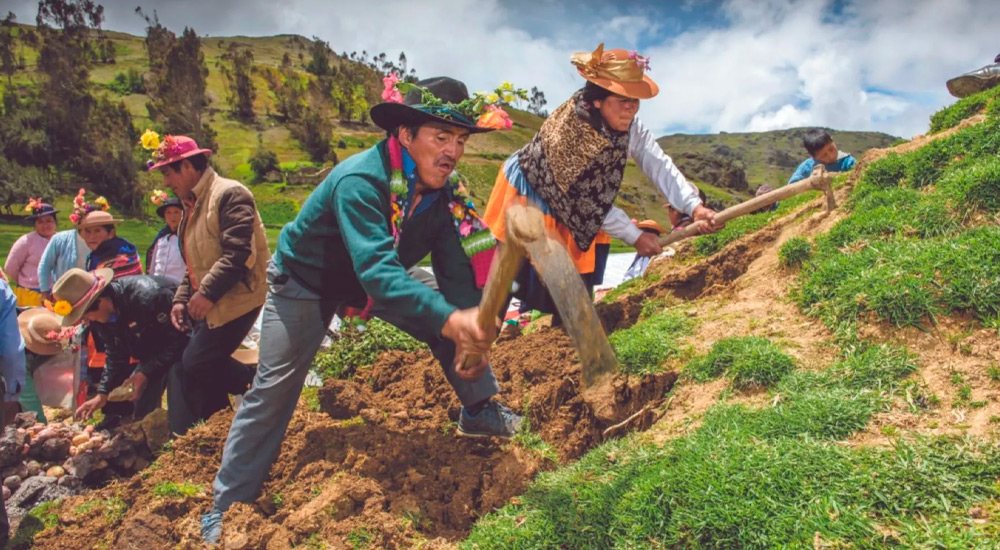
Ancient Superfoods:
Nutritional Wisdom of the Andes: Embark on a journey of nutritional discovery as we delve into the remarkable prowess of Inca superfoods, such as quinoa, amaranth, and maca. These ancient staples, once the well-kept secrets of the Andes, have now transcended their historical roots to garner global acclaim for their profound health benefits.
Quinoa, known as the ‘Mother Grain’ by the Inca, is a testament to the nutritional wisdom of this ancient civilization. Revered for its exceptional protein content, quinoa provides all nine essential amino acids, making it a complete protein source. This tiny grain is a nutritional powerhouse, offering a rich array of vitamins and minerals, including B-vitamins, iron, magnesium, and manganese. Its high fiber content supports digestive health, while its low glycemic index helps maintain steady blood sugar levels. As a gluten-free alternative, quinoa has found a dedicated place on the plates of those with dietary restrictions and health-conscious individuals worldwide.
Amaranth, another ‘lost crop of the Incas,’ is celebrated for its exceptional nutrient density. It boasts high protein levels, rivaling that of quinoa, and offers an abundance of vitamins and minerals, including calcium, iron, potassium, and vitamin C. Its rich, nutty flavor adds a unique dimension to various dishes. Amaranth is also gluten-free, making it an attractive choice for those with celiac disease or gluten sensitivity.
Maca, often referred to as the ‘Peruvian Ginseng,’ is renowned for its adaptogenic properties. This remarkable root, native to the high-altitude Andes, is a source of essential vitamins, such as vitamin C and B-vitamins. Maca is celebrated for its potential to enhance energy, endurance, and stamina, making it a popular choice among athletes and those seeking an all-natural energy boost. Additionally, it is known to support hormonal balance, contributing to overall well-being.
These Inca superfoods have not only sustained indigenous populations for centuries but are also now embraced by health-conscious individuals around the world. Their health benefits extend beyond basic nutrition, encompassing the potential to enhance physical performance, support weight management, and contribute to overall vitality. As we celebrate these nutritional treasures, it becomes evident that the ancient wisdom of the Andes continues to enrich and nourish our modern understanding of well-being.
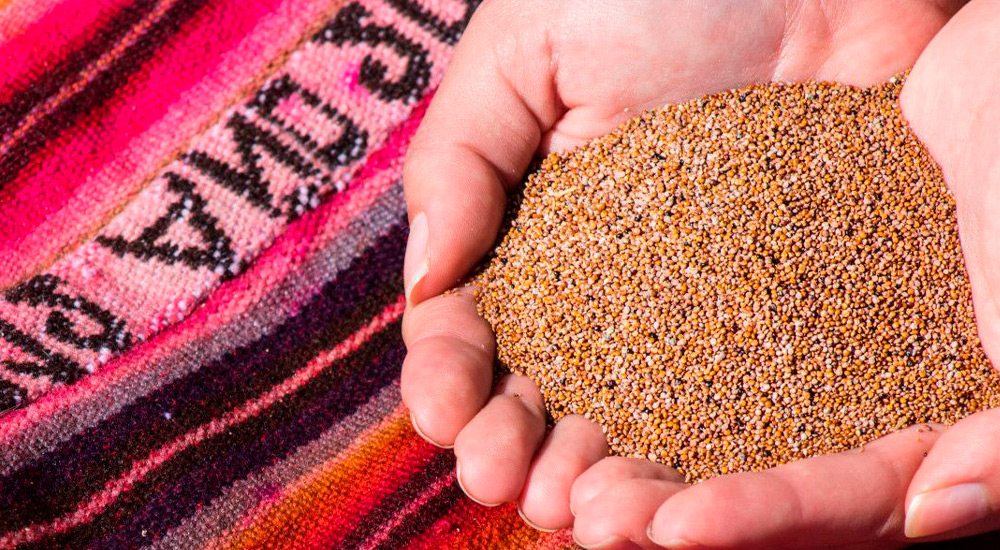
Pachamanca:
Earth Oven Magic: Embark on a captivating exploration of the traditional Andean cooking method known as Pachamanca, a practice deeply rooted in the region’s cultural and culinary history. This ancient technique, which dates back centuries, is a testament to the ingenuity and reverence of the Andean people for the bounties of the earth. Pachamanca is a culinary art form that transcends ordinary cooking, infusing dishes with a distinctive taste and essence that can only be achieved through this unique process.
Pachamanca is more than just a cooking method; it’s a ritual, a celebration of the land’s generosity, and a communal experience that unites people through shared preparation and enjoyment. At its core, it involves cooking various ingredients—such as marinated meats, potatoes, tubers, grains, and aromatic herbs—underground. What makes this practice truly magical is the way it seamlessly blends ancient wisdom with the primal elements of earth, fire, and air.
To begin, a pit is dug in the earth, and stones are heated until they glow red-hot in an open flame. These stones, known as “huankarpo” or volcanic rocks, hold a vital role in the process. The marinated ingredients, often wrapped in banana leaves for added flavor, are carefully layered atop these stones. A layer of herbs, typically huacatay (Peruvian black mint) and oregano, is added to infuse the food with exquisite aromas.
The next step is where the enchantment occurs. The red-hot stones are placed on top of the ingredients, releasing bursts of steam as they make contact. The pit is swiftly sealed with earth, creating an underground pressure cooker. Over the course of about an hour, the ingredients are transformed. The intense heat, steam, and herbal fragrances meld into a symphony of flavors that penetrate and permeate every morsel.
As the earthy oven works its magic, the participants often come together in joyful anticipation, and sometimes even engage in music, dance, or storytelling, making the entire experience a cultural celebration. When the moment of unveiling arrives, the earth is carefully removed to reveal a treasure trove of succulent, tender dishes infused with the unique essence of Pachamanca. The flavors and textures are a testament to the harmonious blend of tradition, nature, and community.
Pachamanca is a living tradition that exemplifies the Andean people’s respect for the land and their profound connection with the natural world. This age-old culinary art continues to be a source of inspiration for those seeking to experience the deep-rooted traditions of the Andes and the extraordinary flavors that emerge from this mystical, underground cooking process.

Chicha:
The Spirit of Fermented Beverages: Allow your taste buds to journey through time as you savor Chicha, the iconic fermented corn beverage of the Inca civilization. This revered elixir is steeped in history and tradition, representing not just a drink, but a cultural heritage that endures in modern Peru. As you sip this sacred brew, you’re partaking in a centuries-old practice that remains at the heart of cultural celebrations and communal gatherings.
Chicha is more than a beverage; it’s a symbol of unity, an expression of hospitality, and a bridge between the past and the present. Its production begins with maize, a staple crop in the Andean diet, which is painstakingly prepared through a process that blends ancient wisdom with the art of fermentation.
The preparation of Chicha involves soaking maize kernels in water and then allowing them to germinate. Once germination is complete, the maize is dried and ground into a coarse flour known as “mote.” This ground maize is then mixed with water, herbs, and spices, which can include everything from aromatic herbs like huacatay to sweeteners like honey or the native molasses called “chancaca.”
However, what makes Chicha truly fascinating is its natural fermentation process. Traditionally, this fermentation was initiated by chewing maize and spitting it into the brewing vessel, where enzymes in human saliva convert the starches in the maize into sugars. This method, though unconventional by modern standards, is a testament to the resourcefulness of the Inca people.
As the maize mixture ferments, it transforms into a mildly alcoholic beverage with a unique taste that combines earthy and sweet flavors. The end result is a drink that captures the essence of the Andean landscape and the warmth of communal gatherings.
Chicha holds a special place in cultural celebrations and rituals, where it is shared as a gesture of hospitality and togetherness. It is a symbol of unity, used to strengthen social bonds, resolve disputes, and celebrate important life events. During festivals and fiestas, Chicha is often the heart and soul of the festivities, infusing the air with the spirit of joy and camaraderie.
Today, Chicha is not just a historic relic but a living tradition. While the traditional method of preparation still exists, modern versions of Chicha have emerged, including a non-alcoholic version that appeals to a broader audience. However, the essence of Chicha remains unchanged—a timeless reminder of the enduring cultural heritage of the Inca civilization.
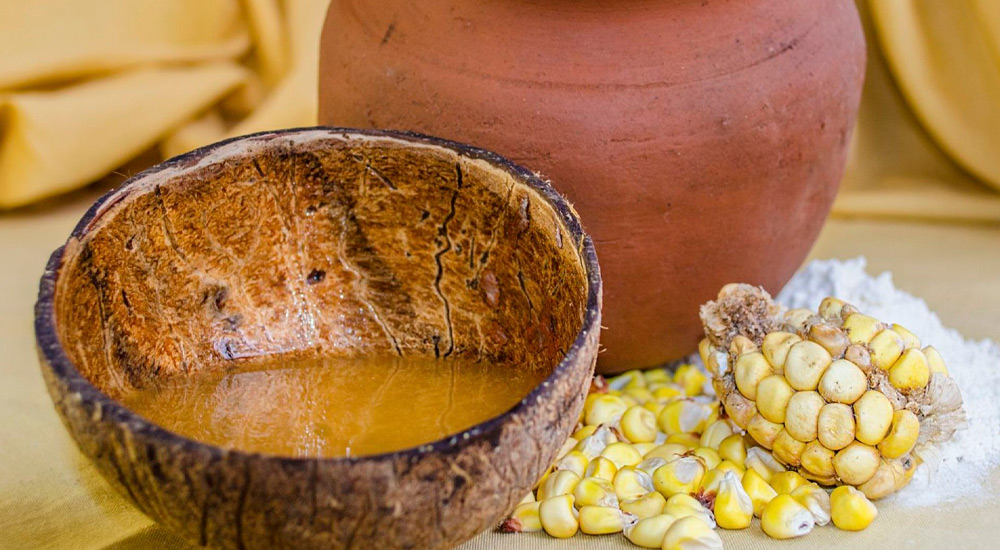
Preserving Inca Culinary Legacy:
Modern Twists & Traditions: Embark on a culinary journey that seamlessly bridges the past and present, where modern fusion dishes are masterfully crafted using Inca ingredients, standing shoulder-to-shoulder with traditional recipes lovingly preserved by dedicated culinary artisans.
In the heart of Peru’s contemporary culinary scene, innovation and tradition coexist in perfect harmony. Talented chefs draw inspiration from the treasures of Inca gastronomy, elevating ancient ingredients to new heights. These chefs are culinary artists, weaving the timeless allure of quinoa, amaranth, and native potatoes into a vibrant tapestry of flavors that captivate the senses.
Modern fusion dishes pay homage to Inca superfoods, celebrating their nutritional richness and adaptability. You’ll discover dishes that ingeniously combine quinoa with global ingredients, creating a delightful fusion that marries local heritage with international flair. The result is a delectable fusion of tastes, textures, and influences, where the ancestral meets the avant-garde.
But it’s not just about innovation; Peru’s culinary landscape remains deeply rooted in tradition. Across the country, there are passionate culinary artisans who preserve the age-old recipes of their ancestors. These guardians of tradition take great pride in cooking techniques that have been handed down through generations. They skillfully prepare dishes that offer an authentic taste of Inca cuisine, from the comforting ‘papa a la huancaína,’ a potato dish with a creamy chili sauce, to the flavorsome ‘rocoto relleno,’ a spicy stuffed pepper dish.
The essence of Inca traditions extends beyond the ingredients and techniques—it’s about the stories and cultural significance that infuse each dish. Every bite taken is an invitation to delve into the historical narratives, rituals, and values that have shaped Peruvian culture for centuries.
As you savor these dishes, you’ll find that the modern and the traditional are not opposing forces but rather complementary facets of Peru’s culinary identity. The fusion of flavors represents a bridge connecting the country’s rich heritage with its dynamic future, all served on a platter of passion, creativity, and an unyielding dedication to preserving the spirit of Inca gastronomy. Whether it’s the contemporary culinary trends or the timeless traditions, both offer an unforgettable and delectable exploration of Peru’s vibrant culinary landscape.
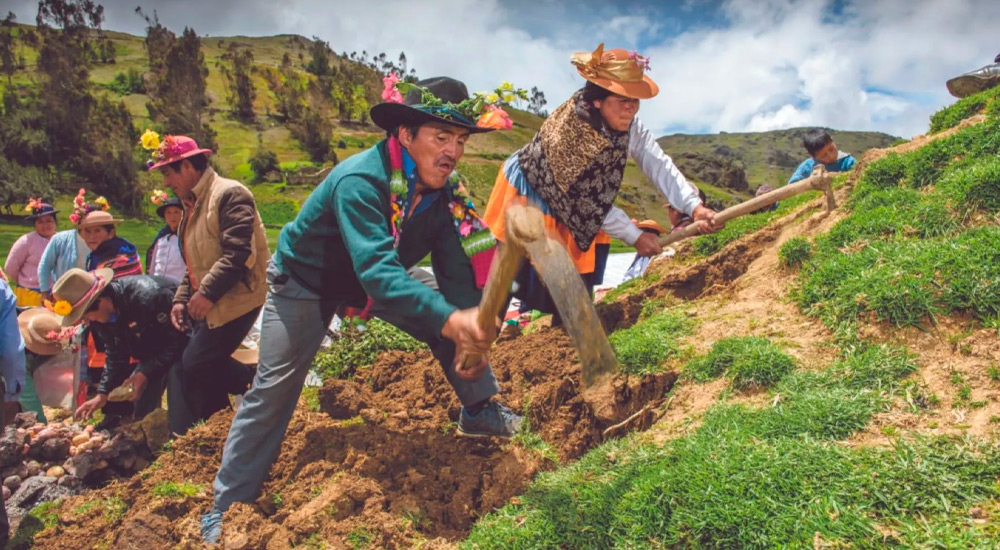
Food as Ritual:
Sharing the Bounty of Pachamama: Embark on a cultural journey that unravels the profound role of food in Inca rituals, illuminating how it served as a bridge between the earthly realm and the divine, and how it was instrumental in nurturing the bonds of community and spirituality.
Food in the Inca civilization was not merely sustenance; it was a sacred expression of gratitude to Pachamama, the revered Earth Goddess. Every harvest was a testament to the earth’s generosity, and the Inca people celebrated this abundance with elaborate rituals and offerings. These ceremonies were deeply intertwined with their spiritual beliefs, reinforcing the idea that the act of planting, growing, and harvesting was a sacred covenant with the land itself.
As part of these rituals, the Inca offered the first fruits of the harvest to the gods, often including corn, potatoes, and other agricultural staples. These offerings, known as ‘pagapu,’ were presented with great reverence and gratitude, acknowledging the essential role of Pachamama in sustaining life. The reciprocal relationship between the people and the land was a central tenet of Inca spirituality.
These offerings were not just about appeasing deities; they were also about fostering a sense of unity among the people. Sharing in these rituals, whether during planting festivals or harvest celebrations, created a profound sense of community and interconnectedness. It was a time for storytelling, music, dance, and feasting, all of which strengthened social bonds and preserved the cultural identity of the Inca.
The act of sharing food, particularly in communal settings, held immense significance in Inca society. Large pots filled with nutritious stews were prepared for the community to partake in. This communal dining not only fed the body but also nourished the spirit and the bonds of kinship. The Inca people believed that by sharing meals, they were forging a connection with the divine, as well as with one another. It was a reminder that their collective strength was their greatest asset.
As you delve into the world of Inca rituals and the profound role that food played in them, you’ll come to understand that the sharing of a meal was not a mundane act but a profound spiritual and communal experience. It was a way of acknowledging the land’s abundance, expressing gratitude to the gods, and strengthening the ties that bound the Inca people together as a unified and resilient community.
Places where culinary traditions are preserved in Peru.
The Ancestral Inca Culinary Traditions: Journey through the landscapes of Peru, and you’ll discover that the time-honored Inca culinary traditions continue to flourish in various corners of the country, particularly in rural areas and among indigenous communities. These cultural oases include the revered Sacred Valley of the Incas, the historically rich city of Cusco, the breathtaking expanses of the Andean region at large, and the lush tapestry of the Peruvian Amazon.
In these regions, the flame of Inca gastronomy burns brightly, casting a warm glow over a culinary heritage that has endured through the ages. The recipes that have been passed down from generation to generation remain an integral part of daily life, a testament to the enduring legacy of the Inca civilization.
As you explore these culinary enclaves, you’ll encounter emblematic dishes that have become cultural touchstones. The roasted guinea pig, known as ‘cuy,’ is a delicacy that has deep roots in Inca cuisine and is still savored today. The meticulous preparation of ‘cuy’ includes a slow-roasting process that imparts a unique and delectable flavor, a true testament to the time-honored artistry of Inca culinary techniques.
Pachamanca, another culinary treasure, is a celebration of the earth’s bounty and a communal experience that endures in various regions. In this traditional method of cooking, an array of ingredients is marinated and then cooked beneath the earth’s surface, infusing them with the flavors of the earth itself. Pachamanca represents not just a meal but a vibrant expression of gratitude for Pachamama, a way of honoring the land’s enduring generosity.
Inca culinary heritage is also evident in the unwavering use of native ingredients such as the versatile and abundant potato in its numerous varieties. Quinoa, the ‘Mother Grain’ of the Inca, is another shining example, celebrated for its exceptional nutritional value and used in diverse dishes.
In these regions, Inca culinary traditions are more than just a remnant of the past; they are a living, breathing testament to a culture deeply rooted in its history and traditions. It’s a heritage that transcends the kitchen, permeating every aspect of life, from the planting of crops to the sharing of meals in communal settings. As you savor these flavors and experience the warmth of the people who carry these traditions forward, you become a part of the ongoing narrative of Inca culinary excellence, an enduring legacy that refuses to be forgotten.
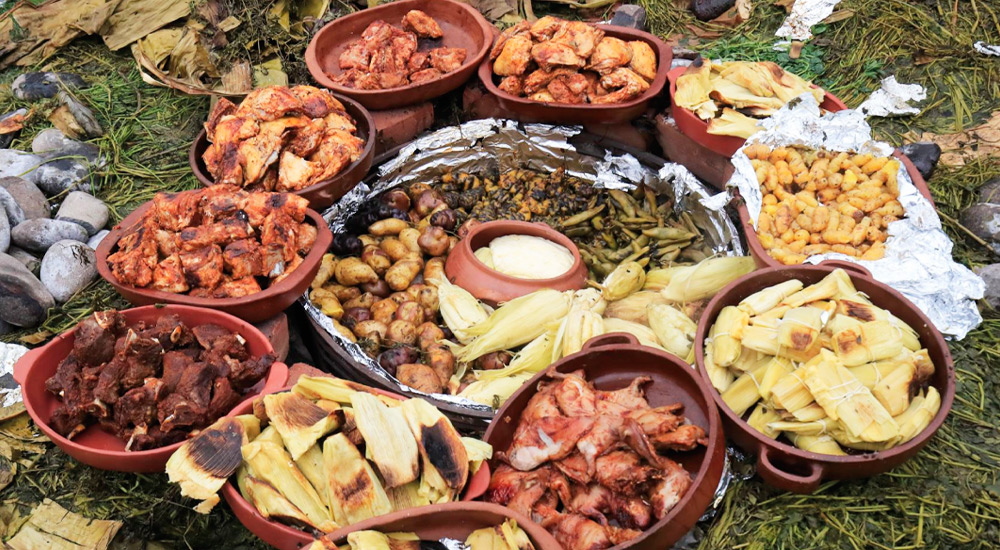
Celebrate the Enduring Flavors and Culinary Wisdom: Join us in a culinary odyssey that invites you to celebrate the timeless flavors and profound culinary wisdom of the Inca civilization, where the threads of ancient traditions seamlessly entwine with the vibrant tapestry of modern gastronomy. This remarkable fusion offers a unique and tantalizing journey through the annals of history and the dynamic evolution of Peru’s culinary landscape.
The heart of this celebration is the enduring legacy of Inca culinary heritage, where recipes, techniques, and ingredients passed down through centuries remain as vital and relevant as ever. Each dish is a living testament to the Inca’s reverence for the earth’s bounty and the profound spiritual connection they maintained with the act of nourishment.
Savoring the richness of Inca heritage is more than a culinary delight; it’s an immersion into the heart and soul of a culture. It’s a chance to experience the history of a people who cultivated the land, celebrated its gifts, and translated their gratitude into artful dishes. The flavors that emanate from these culinary traditions not only captivate the taste buds but also nourish the spirits of those fortunate enough to partake in this remarkable journey.
As you sit down to a feast that marries tradition with innovation, you’re participating in a ritual that transcends mere sustenance. It’s an expression of gratitude to Pachamama, a tribute to the ancestors, and a testament to the unyielding spirit of the Inca civilization that continues to flourish within modern Peruvian culture. It’s a celebration of Peru’s extraordinary culinary landscape, where history, culture, and cuisine converge to create an unforgettable and transformative dining experience that feeds both body and soul.







